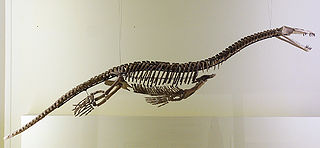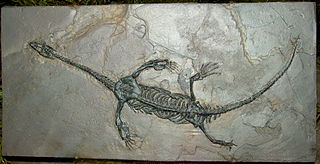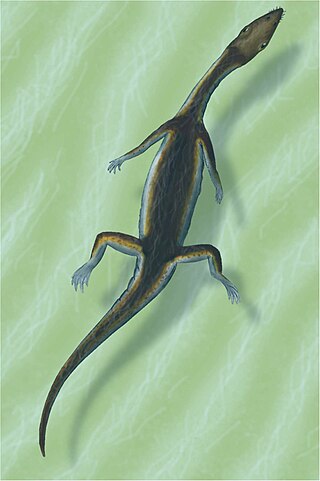
Nothosaurs were Triassic marine sauropterygian reptiles. They averaged about 3 metres (10 ft) in length, with a long body and tail. The feet were paddle-like, and are known to have been webbed in life, to help power the animal when swimming. The neck was quite long, and the head was elongated and flattened, and relatively small in relation to the body. The margins of the long jaws were equipped with numerous sharp outward-pointing teeth, indicating a diet of fish and squid.

Nothosaurus is an extinct genus of sauropterygian reptile from the Triassic period, approximately 240–210 million years ago, with fossils being distributed throughout the former Tethys Ocean, from North Africa and Europe to China. It is the best known member of the nothosaur order.

Pachypleurosauria is an extinct clade of primitive sauropterygian reptiles from the Triassic period. Pachypleurosaurs vaguely resembled aquatic lizards, with elongate forms ranging in size from 0.2–1 metre (0.66–3.28 ft), with small heads, long necks, paddle-like limbs, and long, deep tails. The limb girdles are greatly reduced, so it is unlikely these animals could move about on land. The widely spaced peg-like teeth project at the front of the jaws, indicating that these animals fed on fish. In the species Prosantosaurus, it was observed that they fed on small fishes and crustaceans which they devoured entirely and that its teeth regrew after they broke off. This was the first observation of tooth replacement in a European pachypleurosaur, with the only other discovery of such an event having been made in China.

Ceresiosaurus is an extinct aquatic genus of lariosaurine nothosaurid sauropterygian known from the Middle Triassic of Monte San Giorgio, southern Switzerland and northern Italy. Ceresiosaurus, meaning "Lizard of Ceresio". The type species, Ceresiosaurus calcagnii, was named by Bernhard Peyer in 1931. C. calcagnii is known from both the Cava superiore and Cava inferiore beds of the Lower Meride Limestone at Monte San Giorgio, dating to the latest Anisian of the Middle Triassic. Rieppel (1998) suggested that the back then monospecific genus Ceresiosaurus, is a junior synonym of the better known Lariosaurus, yet he kept it type species as a separate species under the new combination L. calcagnii. In 2004, however, this synonymy was objected by Hänni who described and name a second species of Ceresiosaurus, C. lanzi - a separation supported by several other authors since. This species is known only from the stratigraphically younger Cassima beds of Monte San Giorgio, although also from the Lower Meride Limestone, dating to possibly the lowest Ladinian age. The species in a subtropical lagoonal environment with varying open marine influences, and alongside many related but smaller species of nothosaurids and pachypleurosaurids. Ceresiosaurus represents one of the largest vertebrate of up to 3 m (9.8 ft) snout-tail length from the very diversified paleoenvironment of the Middle Triassic Monte San Giorgio.

Keichousaurus is an extinct genus of pachypleurosaurian marine reptile from the Chialingchiang and Falang Formations of China with two known species attributed to the genus: K. hui and K. yuananensis.

Anarosaurus is an extinct genus of pachypleurosaurs that lived in the Middle Triassic period (Anisian) and has been found in the Jena Formation and the Karlstadt Formation of Germany and the Winterswijk Quarry of The Netherlands. Two species are known: A. pumilio and A. heterodontus. The holotype of A. pumilio was originally housed at the Institut und Museum fur Geologie und Palaontologie, Georg-August-Universitat, Gottingen, but can no longer be located today because it was lost or destroyed during World War II. Anarosaurus was a small reptile with an estimated body length of 50–60 cm (1.6–2.0 ft).

Rhizocorallium is an ichnogenus of burrow, the inclination of which is typically within 10° of the bedding planes of the sediment. These burrows can be very large, over a meter long in sediments that show good preservation, e.g. Jurassic rocks of the Yorkshire Coast, but the width is usually only up to 2 cm, restricted by the size of the organisms producing it. It is thought that they represent fodinichnia as the animal scoured the sediment for food.

Serpianosaurus is an extinct genus of pachypleurosaurs known from the Middle Triassic deposits of Switzerland and Germany. It was a small reptile, with the type specimen of S. mirigiolensis measuring 75 cm (2.46 ft) long.

Simosaurus is an extinct genus of marine reptile within the superorder Sauropterygia from the Middle Triassic of central Europe. Fossils have been found in deposits in France and Germany that are roughly 230 million years old. It is usually classified as a nothosaur, but has also been considered a pachypleurosaur or a more primitive form of sauropterygian.
Dianopachysaurus is an extinct genus of pachypleurosaur known from the lower Middle Triassic of Yunnan Province, southwestern China. It was found in the Middle Triassic Lagerstätte of the Guanling Formation. It was first named by Jun Liu, Olivier Rieppel, Da-Yong Jiang, Jonathan C. Aitchison, Ryosuke Motani, Qi-Yue Zhang, Chang-Yong Zhou and Yuan-Yuan Sun in 2011 and the type species is Dianopachysaurus dingi, thanking a Professor Ding for his help.

Sinosaurosphargis is an extinct genus of basal marine saurosphargid reptile known from the Middle Triassic Guanling Formation of Yunnan and Guizhou Provinces, southwestern China. It contains a single species, Sinosaurosphargis yunguiensis.

Corosaurus is an extinct genus of pistosauroid known from Wyoming of the United States. The holotype measured about 1.65 m (5.4 ft) long, while larger specimens would have belonged to individuals measuring more than 4 m (13 ft) long.
Hanosaurus is an extinct genus of marine reptiles that existed during the Triassic period in what is now China. The type species is Hanosaurus hupehensis. It was a small animal, with specimens measuring 79.4 cm (31.3 in) long in total body length, which likely fed on soft-bodied prey.
Gogolin Formation – Triassic geologic formation, hitherto named the Gogolin Beds, is the lowermost lithostratigraphical unit of the Lower Muschelkalk in the Silesian-Cracow Upland, underlain by the Upper Buntsandstein carbonates and overlain by the Górażdże Formation carbonates.
Eohupehsuchus is a genus of extinct aquatic diapsid from the Upper Spathian of Hubei Province, located in Central China. The genus is monotypic and belongs to the order Hupehsuchia, whose members are characterized by toothless beak-like snouts, a row of dermal plates along their backs, and aquatic adaptations including paddle-shaped limbs and fusiform bodies with pachyostotic ribs.

Saurosphargidae is an extinct family of marine reptiles known from the Early Triassic and early Middle Triassic of Europe and China.
Panzhousaurus is an extinct genus of pachypleurosaur from the Middle Triassic of China. The type species is P. rotundirostris. The preserved portion of the holotype measures 36 cm (14 in) long, and its total body length may have been less than 50 cm (20 in).

Dianmeisaurus is an extinct genus of pachypleurosaur from the Middle Triassic Guanling Formation in China. The type species is D. gracilis. An additional species, D. mutaensis, was named in 2024 based on a small skeleton likely belonging to an immature individual.
This list of fossil reptiles described in 2014 is a list of new taxa of fossil reptiles that were described during the year 2014, as well as other significant discoveries and events related to reptile paleontology that occurred in 2014.
Marcianosuchus is an extinct genus of eucrocopodan archosauriforms from the Middle Triassic Röt Formation of Germany. The genus contains a single species, M. angustifrons, known from a partial disarticulated skeleton. Marcianosuchus represents the first non-archosaurian archosauriform named from Central Europe.



















